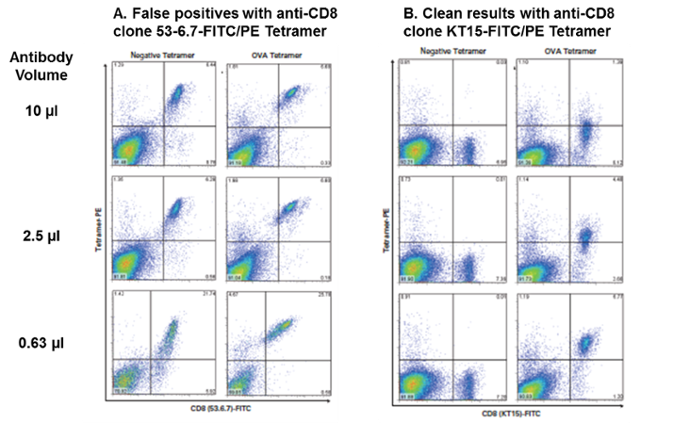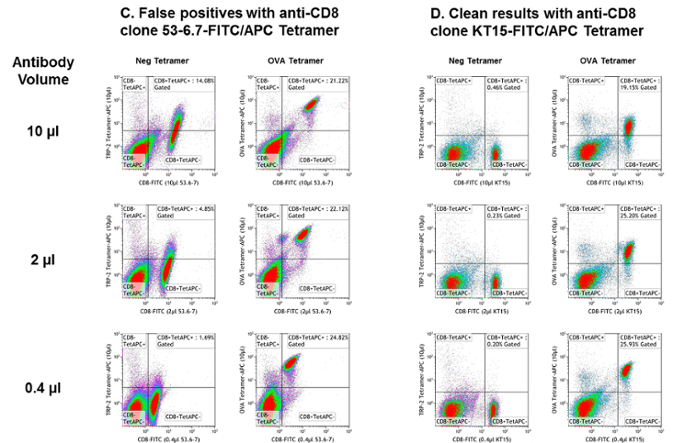You’re sitting at your flow cytometer, staring at your CD8 x tetramer plot in anticipation of a tiny but meaningful group of dots appearing in the upper right quadrant. You hold your breath, click “acquire,” and watch… Wait, what? What’s this ugly diagonal?? How come ALL the CD8 positives are dual positive??! Hey, this is my control mouse! That one should be completely tetramer negative! Yep, I’ve been there too. Classic case of using a CD8 antibody that doesn’t play nice with tetramers.
How To Reduce CD8 Antibody Interference With H-2 Kb Tetramer
Certain anti-murine CD8 clones have been shown to affect tetramer staining1-6. In Current Protocols in Immunology, Altman and Davis caution, “Some MHC tetramers (e.g., H-2 Kb) have been observed to stain all CD8+ T cells, presumably via an interaction between CD8 and the α3 domain of the MHC molecule. In these cases, it is useful to perform a cross-titration series with the MHC tetramer and several distinct anti-CD8 antibodies, looking for CD8 antibodies which block with CD8-mediated interaction, but not the antigen-specific interaction. For example, Kb tetramers bind to all CD8+ T cells in the presence of the anti-CD8 antibody 53-6.71.
We tested two different anti-murine CD8 FITC clones used to stain OT-I transgenic splenocytes with Negative (β-gal, A-B; TRP2, C-D) or OVA-specific (A-D) H-2 Kb tetramer. The use of anti-murine CD8 clone KT15 (B, D) eliminates confusing diagonals resulting from non-specific binding seen with clone 53-6.7 (A, C) in tetramer assays. PE-labeled tetramers (A, B) and APC-labeled tetramers (C, D) are shown. Titration of anti-murine CD8 antibody is recommended for optimized staining.
Check out KT15, the CD8 antibody clone that behaves!
Anti-CD8 (Mouse) mAb-Alexa Fluor® 647
References
- Altman JD, Davis MM. 2003. MHC-peptide tetramers to visualize antigen-specific T cells. Curr Protoc Immunol. 17(17.3 Suppl 53): 23.
- Wooldridge L, Lissina A, Cole DK, van den Berg HA, Price DA, and Sewell AK. 2009. Tricks with tetramers: how to get the most from multimeric peptide–MHC. Immunology. 126:147-64.
- Wooldridge L, Scriba TJ, Milicic A, Laugel B, Gostick E, Price DA, Phillips RE, Sewell AK. 2006. Anti-co-receptor antibodies profoundly affect staining with peptide–MHC class I and class II tetramers. Eur J Immunol. 36:1847–55.
- Holman PO, Walsh ER and Jameson SC. 2005. Characterizing the impact of CD8 antibodies on Class I MHC multimer J Immunol. 174:3986-3991.
- Wooldridge L, Hutchinson SL, Choi EM et al. 2003. Anti-CD8 antibodies can inhibit or enhance peptide–MHC class I (pMHCI) multimer binding: this is paralleled by their effects on CTL activation and occurs in the absence of an interaction between pMHCI and CD8 on the cell surface. J Immunol. 171:6650–60.
- Daniels MA, Jameson SC. 2000. Critical role for CD8 in T cell receptor binding and activation by peptide/major histocompatibility complex multimers. J Exp 191:335–46.


